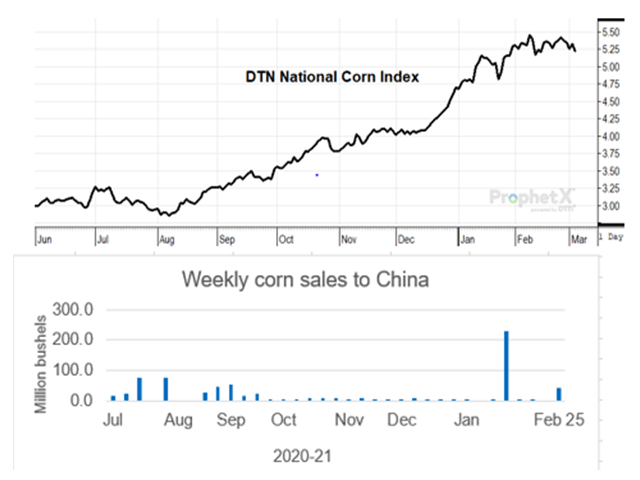Todd's Take
The Grain Trade Conversation Begins
In last week's Todd's Take (https://www.dtnpf.com/…), I explained how China's role in international grain trade has grown from non-existent to troublesome in just 30 short years, and offered eight recommendations for what the U.S. could do to better prepare for the new landscape of ag trade in the 21st century.
I invited those more knowledgeable on trade to email me in hopes of expanding the conversation and coming up with even better ideas. I'm glad to say several did, and I'll share some of those responses below. I promise next week's Todd's Take will get back to the usual market analysis.
The award for the most educational conversation of the week goes to Jay O'Neill. Jay is the proprietor of HJ O'Neill Commodity Consulting and has years of experience as an arbitrator with the National Grain and Feed Association (NGFA) and the North American Export Grain Association (NAEGA).
O'Neill explained nearly all the export-sale cancellations we see in USDA's weekly reports are carried out in a way that is mutually acceptable to both buyers and sellers. He said cancellations are a normal part of business that take into account changing conditions. O'Neill differentiates between cancellations, which he sees as acceptable to both parties, and defaults, which he says are rare.
I asked about the perception that China buys grain from the U.S. in the fall and then waits to see how Brazil's crops turn out months later, in essence, giving itself a risk-free trade.
O'Neill could only think of two times when exporters were left with substantial losses -- the most recent happening in 2014. Overall, he explained, cancellations are not a detrimental issue, and I was convinced to give up on the idea of a national restocking fee.
P[L1] D[0x0] M[300x250] OOP[F] ADUNIT[] T[]
Several people I talked to made valid points that the Chinese government may not even know their own grain supply situation very well. It's a big country of diversified rural areas with no strong statistical reporting effort to keep track of production and inventories. China has come a long way in 30 years, but in terms of information gathering, it still has a long way to go.
That is an important part of the conversation and should have been included last week. Unfortunately, it doesn't make the U.S. any less vulnerable to sudden, unexpected changes in demand.
Pertaining to the topic of when do U.S. exporters have to report sales to foreign countries, the opinion from the Office of General Counsel of USDA was pretty clear. As mentioned last week, sales to all representatives of foreign buyers must be reported by the next business day, even if the agent maintains an office in the U.S.
However, one market veteran I spoke with explained that U.S. grain trade is so intertwined with Chinese firms in the U.S., it is likely that a Chinese firm could secure corn for U.S. domestic trade, within the rules, only to change and report the corn as purchased for export at a later date. The specific loophole remains unclear, but if that scenario is correct, the U.S. public would have no idea when sales intended for export were actually made, and the market's ability to reflect demand would be seriously compromised.
It won't surprise anyone that the harshest criticisms of last week's column came in 140-character bursts from people on Twitter. What was surprising was the number of tweets that see no problem with China's trade advantages.
The one idea I will continue to be a pest about is the need for USDA to move toward monthly grain stocks reports. I know it's not in USDA's budget and many don't yet see the need, but I'm confident it will eventually happen.
If we take a breath and consider the increasingly impossible task that USDA has -- trying to make supply and demand estimates for the U.S. while knowing very little about the world's largest feed grain consumer (among all the other uncertainties) -- one of the only viable alternatives for tracking the market's vitals is to measure U.S. grain stocks on a monthly basis.
Part of the difficulty of this conversation is that it can quickly turn into USDA bashing, and that's not my intent. I don't envy the size of the task in front of USDA, and if there was ever a challenge for U.S. agriculture that required a collaborative effort, this has to be one of the larger ones.
In 1990, there were roughly 5.3 billion people in the world, and in terms of grain trade, China was largely asleep, leaving a much smaller world to fundamentally assess. U.S. grain customers were geographically diversified, and none of them had the ability to single-handedly disrupt markets the way China does today. And China's influence is not going to get any smaller the next 10 years.
For U.S. farmers that were facing an extremely bearish scenario less than one year ago, I am thankful for the higher prices China's demand has brought in 2021, but we shouldn't let that lull us into thinking all is well.
Todd Hultman can be reached at Todd.Hultman@dtn.com
Follow him on Twitter @ToddHultman1
(c) Copyright 2021 DTN, LLC. All rights reserved.




